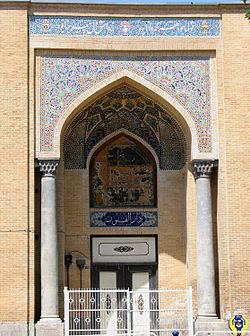Type Polytechnic | Established 1851 (1851) Headquarters Tehran, Iran | |
 | ||
Motto توانا بود هر که دانا بودز دانش دل پیر برنا بود Motto in English Mighty is he who has knowledgeBy knowledge the old hearts grow young again(couplet from Ferdowsi's Shahnameh) Endowment 7,750 tomans (initially)30,000 tomans (in 1930) Notable alumni Mohammad‑Hossein Shahriar, Kamal‑ol‑molk, Mostafa Chamran, Sadegh Hedayat, Mohammad Ali Foroughi Similar Amirkabir University of Techno, University of Tehran, Academy of Gondishapur, Shahid Chamran University, Shahed University | ||
Dar ul-Funun (Persian: دارالفنون [dɒːɾolfʊˈnuːn], meaning "Polytechnic"), established in 1851, was the first modern university and modern institution of higher learning in Iran.
Contents
Introduction
Founded by Amir Kabir, then the royal vizier to Nasereddin Shah, the Shah of Persia, Dar al-Funun originally was conceived as a polytechnic to train upper-class Persian youth in medicine, engineering, military science, and geology. It was similar in scope and purpose to American land grant colleges like Purdue and Texas A&M. Like them, it developed and expanded its mission over the next hundred years, eventually becoming the University of Tehran.
The institute was planned by the Iranian educated Mirza Reza Mohandes, and built by the architect Muhammad Taqi Khan Memar-Bashi under the supervision of the Qajari prince Bahram Mirza. Facilities such as an assembly hall, a theater, library, cafeteria, and a publishing house were built for the institute. In 1930, the building was destroyed by Mirza Yahya Khan Qaragozlu (also known as Etemad-od-Dowleh), then Minister of Education, and rebuilt based on a Russian engineering design.
Many parts of the institute were later on absorbed and merged into the newly establishing Tehran University. The Faculty of Medicine for example, was particularly the successor to the Dar ul-Funun Department of Medicine, established in 1851, which had become the School of Medicine (Madreseh-ye tebb) in 1919.
The elite school was training 287 students by 1889, and had graduated 1100 students by 1891. During this time, the faculty consisted of 16 European, and 26 Iranian professors.
